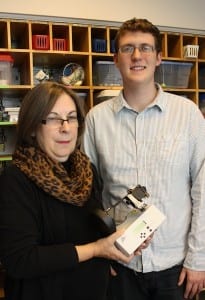PITTSBURGH, October 2013 — An innovative program that introduces robotic technology into non-technical middle school classes will be used by suburban Pittsburgh and rural West Virginia schools in a federally funded research project to identify and nurture students with an affinity for science, technology, engineering and mathematics (STEM).

Director Lou Karas shows WLU senior Ryan Bland one of the robotic kits in the Center for Arts and Education.
All 7th and 8th grade students at Springdale Junior-Senior High School and all 6th, 7th and 8th grade students in the Mingo County, W.Va. schools – a total of 900 children annually – will use robotic kits developed at Carnegie Mellon University. They will use the kits to complete at least one project or assignment each year in required courses such as health, earth science and language arts.
The three-year Creative Robotics project, supported by a $1.5 million National Science Foundation grant, seeks to increase the number and diversity of students in the STEM education pipeline.
“We’re particularly interested in finding students who may not realize they have STEM-related talents or interests, or who otherwise have slipped through the cracks,” said Illah Nourbakhsh, CMU professor of robotics and the project’s principal investigator. “Integrating robotics technology into classes such as art or health will give every student multiple opportunities to discover their STEM potential.”
In addition to CMU and the Mingo County and Allegheny Valley school districts, the project includes faculty members in the schools of education at WLU and Marshall University.
“We’ll be working with the CMU researchers to develop the Creative Robotics curriculum and integrate it into our pre-service teacher education program. I will serve as one of the ‘co-principal investigators’ on the project,” said Lou Karas, director of WLU’s Center for Arts and Education.
The project will introduce robotic technology into non-technical middle school classes in the two school districts over the three-year period, she explained.
Nourbakhsh’s CREATE Lab in the CMU Robotics Institute set the stage for this new project in 2006 when it launched a program called Robot Diaries, which later became known as Arts and Bots. The idea was to foster interest in technology at the middle school level, particularly among girls. Rather than focusing on building robots, Arts and Bots used robotic kits to enable students and teachers to turn almost any arts and crafts project into a robot, or something akin to a kinetic sculpture.
The kit, called Hummingbird, consists of a customized control board along with a variety of lights, sensors and motors that can be connected to the controller without soldering. Students program their creations with an easy-to-learn, drag-and-drop environment that requires no prior experience with programming.
Students have used Hummingbird for such projects as a replica of Star Wars’ R2D2, a “coin monster” for an ancient coin exhibit, and models of the human arm and its musculature for a high school anatomy class. Hummingbird is sold through a CMU spinoff company, BirdBrain Technologies.
The CREATE Lab trains teachers on how to use the kits in their classes. More than 1,100 students and about 200 educators in Pennsylvania, West Virginia and Ohio, as well as Brazil and the United Kingdom, have participated in Arts and Bots thus far.
In most cases, however, participation has been limited to a course or two, or just a handful of teachers in each school. With the new Creative Robotics project, Arts and Bots will be introduced into required core courses that all students take.
Faculty members at WLU and Marshall will work with CMU researchers to develop curriculum and bolster teacher training. Harold Blanco, associate professor of education and instructional technology at Marshall, also emphasized the importance of integrating Arts and Bots into pre-service teacher candidate training.
“My goal is to give them the tools needed to not only integrate technology in the classroom but to show them how technology can be multidisciplinary,” Blanco said. “I want my students to graduate already knowing the tools and having skills to implement technology in the classroom.”
The Arts and Bots program was created with the support of the Heinz Endowments, the National Science Foundation and the Benedum Foundation. Marshall and West Liberty are part of a CREATE Lab Satellite Network, which also includes West Virginia University and Carlow University. The network, with support and direction from the Benedum Foundation, provides outreach in each community for the lab’s technology projects.
To contact Karas, please call 304-336-8162.